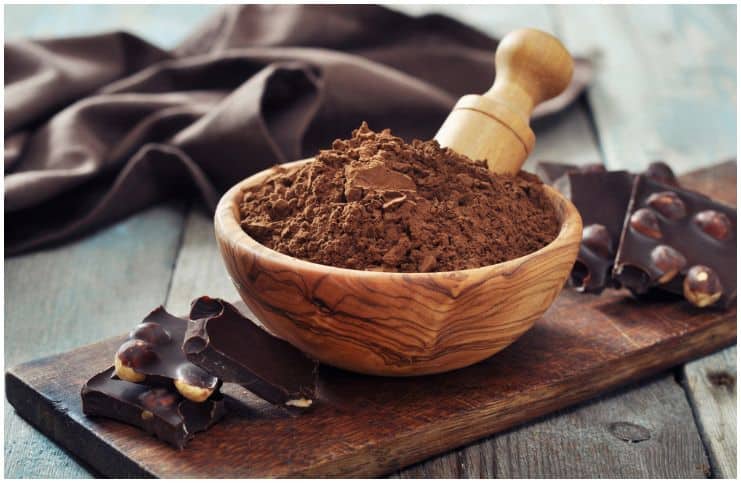Carob Powder (Ceratonia Siliqua) – Side Effects, Facts, Uses, Health Benefits:
Facts
It is the fruit of Ceratonia siliqua tree, which grows spontaneously or is cultivated in the Mediterranean area and the Middle East.
Trees grow tall and strong, with a height of up to 15 m. It is also known as locust bean or Saint John’s Bread.
Because it reproduces easily and withstands harsh conditions of drought, it has adapted well in countries like South Africa, USA, Australia, and Mexico. Its fruits are 10-30 cm long pods, which become brown at maturity. Pods are leathery when ripe and are brown with a wrinkled surface.
Residents from the Mediterranean area used the pods’ sweet floury pulp in various preparations and fermented beverages, and also as animal feed. Gradually, it has fallen into oblivion.
It resurfaced massively on the market in the early 80s, mainly in North America, where the food industry began to replace cocoa, which became expensive after a shortage period. It provides two distinct products: carob gum and carob powder or flour.
Carob gum (E410), a common additive
It is the result of processed seeds, and it appears as a white or yellowish-white powder. It is used as a thickening agent in the food industry and can also be found in beverages, ice creams, puddings, yogurts, and diet products.
It is possible, without even knowing, to eat it almost every day. In contact with water, carob gum forms a gel which, although not absorbed by the body, gives a strong feeling of fullness. Due to this property, carob gum is found in the composition of many slimming supplements.
Carob powder or flour, a healthy food
It is obtained by drying and pulverization of pods. It has the color and subtle taste of caramel, to some extent similar to that of cocoa.
Rich in pectins, quality soluble fibers, and sugars with thickening properties, it has the ability to regulate intestinal transit, recommended both for constipation and diarrhea. In addition, the sugars from it are absorbed slowly and maintain steady blood sugar levels that are beneficial for the body.
Chemical Composition
The pods contain 30-70% carbohydrates (cellulose, glucose, mannose, fructose).
The seeds contain proteins, fats (oleic acid, linoleic acid, palmitic acid, etc.), phytohormones, and tannin.
Health Benefits and Uses of Ceratonia siliqua
- It contains plenty of sugars, similar to fructose.
- It is an important source of minerals (iron, copper), vitamins (B2), and fibers.
- It has 200 percent more calcium compared to cocoa. Adequate daily intake of this essential mineral is important for your bones, as well as your overall health. The people at the highest risk for experiencing a deficiency in this mineral are adolescent girls, children, and postmenopausal women.
- Due to its rich content of calcium and phosphorus, this powder is used in the fight against osteoporosis.
- It improves digestion.
- 100g of this powder contains 4,30 percent DV of potassium. Potassium is a vital mineral for the proper function of all tissues, cells, and organs in the human body. Moreover, eating a diet rich in potassium has excellent health benefits, particularly for individuals afflicted with hypokalemia.
- It inhibits the development of pathogenic intestinal bacteria (it can be used for treating diarrhea in children and adults and restoring intestinal peristalsis).
- It has a low glycemic index (GI represents the level of influence of ingested carbohydrates on blood sugar levels). It releases energy gradually, ensuring long-term satiation.
- As it is very rich in insoluble fibers (it contains 6,3g of dietary fiber, which is 24,40 percent of the recommended daily intake), carob has the ability to naturally reduce cholesterol levels. The beneficial effects on cholesterol levels are boosted by the naturally high content of lignin and polyphenols – powerful antioxidants that are usually present in plant-based foods.
- It is an exceptional antioxidant, thus, helping to lower the damage of free radicals, which are highly reactive compounds that have the potential to harm cells. For example, free radicals may cause LDL cholesterol to oxidize, increasing the risk of cardiovascular diseases.
- It is a good source of phosphorus. Phosphorus, the second most abundant mineral in the body, is needed by your body for teeth and bone formation. Furthermore, this mineral helps in keeping the kidney working effectively. A deficiency of this mineral may lead to – weight loss, loss of appetite, stiff joints, bone pain, weakness, fatigue, or breathing difficulties.
- It doesn’t contain gluten, lactose, caffeine, or theobromine.
- As an alkaline food, it induces basicity within the body; thus, it doesn’t stimulate gastric acidity.
- It contains small amounts of sodium and is recommended for hypertension.
Side Effects of Carob Powder
Consumption of this food is currently not restricted to a certain amount. Therefore, no daily limit has to be respected. However, moderation is recommended.
Enjoy the benefits of this powder by including it in your everyday eating routine, at breakfast or snacks, under various forms!
READ THIS NEXT:
Brown Algae (Phaeophyceae) – Facts
Maca Root (Lepidium meyenii) – Side Effects
Red Algae (Rhodophyta) – Facts
References https://www.ncbi.nlm.nih.gov/pmc/articles/PMC5133875/ https://www.ncbi.nlm.nih.gov/pmc/articles/PMC6096888/
